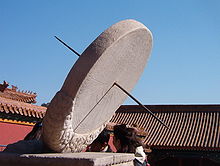Equatorial sundial
The equatorial sundial is one of the three most common types of sundial . The name is based on the position of the dial: it is parallel to the equatorial plane . Its archetype, the hollow-sphere sundial or scaphe , dates back to antiquity. As a mirror image of the celestial sphere , it has the advantage over a flat projection surface that the end point of the shadow moves uniformly.
A pole rod arranged parallel to the earth's axis serves as a shadow projector . It is inclined by the geographical latitude to the horizon and is perpendicular to the equatorial plane. Since the hour angle is defined in the equatorial plane, the dial is scaled linearly, the angle between the hour markers is a constant 15 °.
An equatorial sundial with a flat dial is illuminated only on the top in the summer half-year and only on the bottom in the winter half-year.

Reading from the underside, which is difficult at a large geographical latitude, is unnecessary in the case of a design as a ring-shaped equatorial sundial in the form of an armillary sphere with the scale on an equatorial ring.
On the days around the equinox, a full ring shadows its own scale. If you reduce it to half a ring , this is avoided (however, the display of hours beyond twelve is missing in summer).
The half-ring becomes a half- cylinder surface , for example to accommodate the analemma loops when displaying with time compensation . Such sundials have a point-shaped shadow thrower (nodus) instead of a pole rod.
literature
- René RJ Rohr: The sundial history, theory, function. Callwey Verlag, Munich 1982, ISBN 3-7667-0610-1 , pp. 56-59.
- Arnold Zenkert: The fascination of the sundial. 4th revised and expanded edition. Verlag Harri Deutsch, Frankfurt am Main et al. 2002, ISBN 3-8171-1665-9 .
Web links
Individual proof
- ^ Arnold Zenkert: Faszination Sonnenuhr , Verlag Harri Deutsch, Thun and Frankfurt am Main, 2002, page 49.


